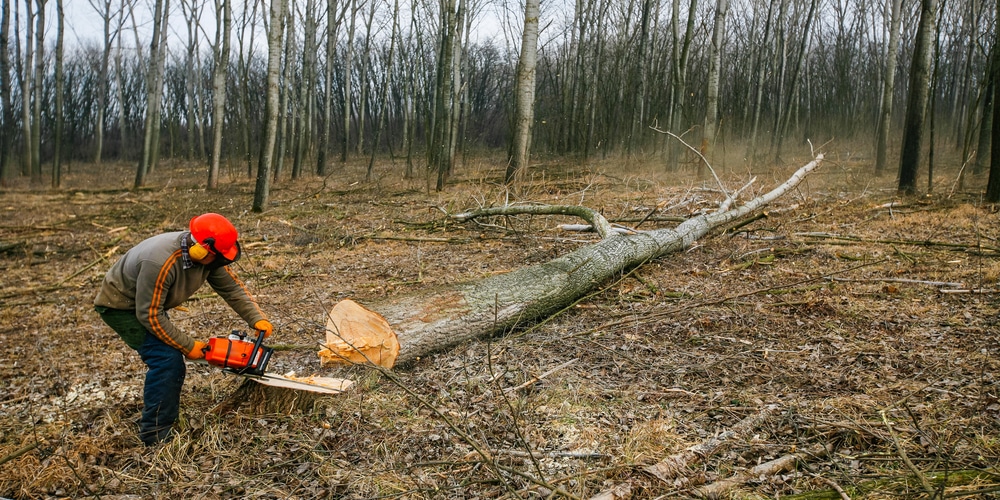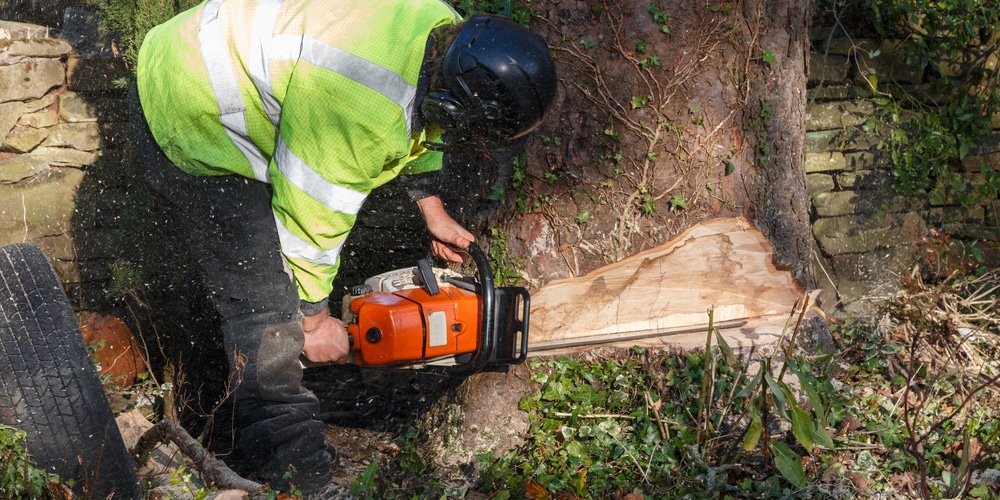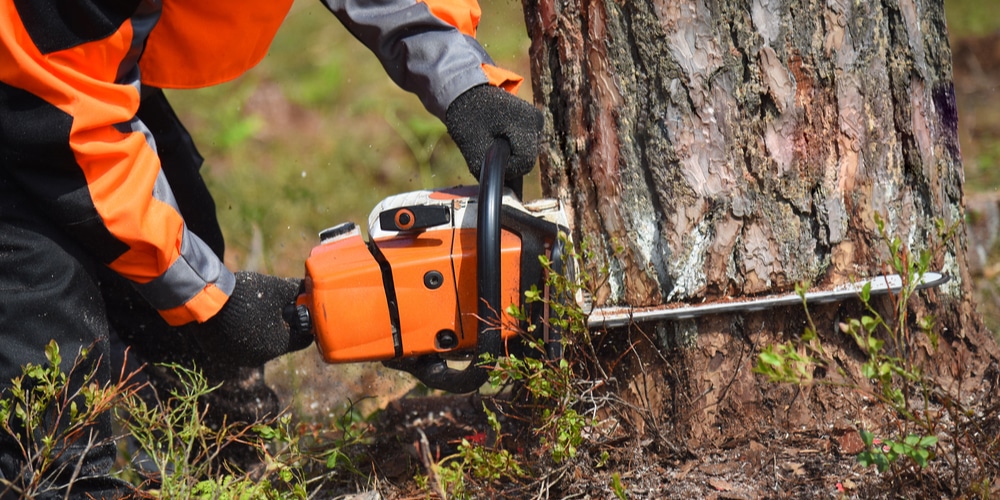Cutting a leaning tree requires you to take precautions, vigilant steps, and orders of operation, even if you have experience in logging. Directing the fall of the leaning tree can prevent risky breakages and kickbacks. Besides, it’s vital to observe the necessary safety practices to protect yourself and other people, equipment, or the buildings within your working areas. In this article, we’ll discuss how to fell a leaning tree safely.
Felling Against the Lean: Required Equipment

When cutting leaning trees, they’ll typically fall in the lean direction. That might be inconvenient or even dangerous particularly if the tree is lying towards properties or another tree. So, how can you fell a tree against the lean? Cutting the tree such that it falls opposite the lean should be your goal. For the job you’ll need:
- Chainsaw
- Extension or tripod ladder
- Strong rigging ropes
- Ground anchor pins
- Felling wedges
- Mallet or Sledgehammer
Here are the steps to follow when felling a tree against the lean:
1. Wear safety gear
Safety is vital when it comes to felling leaning trees. So, you should wear safety gear items, including a logger’s helmet, earmuffs and face screen, safety glasses, and work boots.
2. Assess the situation
You should assess the situation first before putting the saw in the trunk. Study the angle of the lean and obstacles in the way. Move the cars and any moveable property before cutting the tree. If the tree is leaning towards a building, ensure all the residents are out of the house. You also should create more than one escape route when cutting the tree to avoid suffering any injuries.
Don’t feel shy about calling a professional, your life isn’t worth the money.
3. Trim the branches
Typically, a tree has more branches on the leaning side and this increased weight pushes it to fall in that direction. Therefore, you should trim the tree branches before felling the trunk. This will lower the center of gravity and reduce the tree’s weight, making it easier and much safer to fell the tree. Use the extension ladder or tripod ladder (you should secure the extension ladder to the tree using a rope in order to prevent falling or slipping) to climb up and reach upper branches.
4. Use ropes and ground anchor pins
Ropes can be used to guide the tree in the way you want it to safely fall. You’ll also need to hammer your pins into the ground and ensure that they’re sturdy and firm enough to withstand the tree’s weight. Typically, you need to wrap the ropes around the areas close to the treetop and make strong and firm knots. On the other end of the rope, make knots around the ground anchor pin.
5. Make a notch in the direction of the intended fall
You should cut a right-angled notch on the tree side facing the way you intend it to go down. First, undercut at the lower side of the tree up to a third of the trunk’s diameter. Then, create a second cut just above the initial undercut. The second cut needs to be straight and should meet the endpoint of the first undercut to make a wedge-shaped notch that you can easily remove from the tree.
Note: The notch ought to be tied at an elevation that eases cutting and secure chainsaw handling. That is usually at knee height.
6. Make the back cut
On the opposite side, cut straight through the tree using the chainsaw towards the notch. You should cut deep enough (about a third of the tree diameter) to allow the driving of wedges in the trunk while preventing an unexpected fall. The cut should be about an inch above the notch.
7. Drive in the felling wedges
You should leave the saw running in the back cut (but the chain should be locked to avoid accidents). Use the mallet or sledgehammer to push the wedges into the back cut. Depending on the tree size, you can use several wedges to ideally correct the lean. Also, ensure that the wedges don’t contact the saw as it can cause breakage or damage.
8. Complete the felling cut
Finally, you can unlock the saw safely and continue the back cut to the notch. The wedges will push while the ropes will pull the tree towards the direction you want it to fall.
Fell a Tree towards the Lean
While it might seem easier, cutting down a tree in the lean direction can be risky. If done incorrectly; the tree can tear apart and fall towards you speedily, and may cause injuries. Similar to felling a tree against the lean, felling in the direction of the lean requires you to wear protective gear, assess the situation, and trim the branches. Then, follow these steps:
Make a notch: Make a triangular notch on the leaning side of your tree. The notch shouldn’t be too deep (not more than a fifth of the tree diameter) since the tree leverage and lean could push it to fall suddenly.
Make plunge or bore cuts: After making a notch, you should avoid making the standard from the opposite side to avoid breakages. So, you need to cut bores to the side (the cut should be slightly above the notch). Stab the saw slowly into the stem from the side up to the middle of the tree and then repeat from another side. This should create a hinge of wood in between the bore cut and notch and a wood strap between the opposite side of the notch and the boring cut.
Make the felling cut: This entails cutting through the remaining trunk that’s on the other side of the notch towards the plunge cuts. At this point, the remaining hinge will typically be a small percentage of the diameter and hence will allow for the safe felling of the tree.
Special Consideration:
If the tree is leaning towards a dangerous obstacle like a power cable, don’t attempt to cut it yourself. Consider hiring the services of professionals to handle such jobs.
Wedging your tree properly will ensure it fall in the direction you want, but still, be cautious and run to a safe distance, especially if you notice signs of uncontrolled fall.
Make sure that your chainsaw blade is tight. A large tree can do a number on it. Here’s what to do if the chainsaw blade keeps coming off.
Take your time when setting up. Make sure you really understand how to fell the leaning tree.
Bottom Line
Don’t make the mistake of taking leaning trees lightly. If you aren’t confident that you can fell a leaning tree, don’t be afraid to call in an expert.
Felling one can be challenging, but doing it safely is not impossible. You can follow the above steps to ensure that you complete the work without facing issues regardless of the direction you intend to fell the leaning tree.

